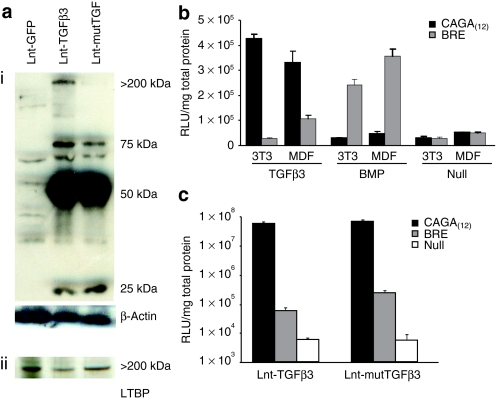Figure 1.
Transduction of murine fibroblasts with lentiviruses encoding TGFβ3 results in efficient transgene expression and functional activation of specific bioresponders. (a) To confirm the presence of transgenic protein in transduced murine dermal fibroblast (MDF) cells, lysates were subjected to western blot under nonreducing conditions with a murine TGFβ3-specific antibody. A strong 50-kDa band was evident in MDF cells transduced with the TGFβ3 containing lentivectors and not in control-transduced cells. This band corresponds to heterodimers of latency-associated peptide-TGFβ3. (i) There were also bands at 25 kDa corresponding to the active homodimer of TGFβ3 and a weaker band at 75 kDa, which corresponds to the predicted size of the uncleaved bicistronic precursor protein GFP.2A.TGFβ3 or GFP.2A.mutTGFβ3. (ii) A >200-kDa band corresponding to the size expected for the TGFβ3/LTBP-1 complex is evident in the wild-type TGFβ3-transduced cells but not the mutant. To confirm this to be the TGFβ3/LTBP-1 complex lysates were blotted with LTBP-1 antibody. (b) Transgenic cell lines were generated from NIH-3T3 cells and primary adult MDFs that contain a single stably integrated copy of either the TGFβ-specific enhancer elements controlling a murine minimal promoter (CAGA(12)) or a bone morphogenic protein–specific Id1 enhancer elements (BRE) both driving the luciferase reporter gene. These cells were validated by exogenous application of either TGFβ3 or BMP4. Cells were lysed 6 hours after cytokine application and assayed for luciferase activity (n = 4 ± SEM). (c) MDF cells, MDF/CAGA(12)-Luc cells, or MDF/BRE-Luc cells were transduced with either Lnt-TGFβ3, Lnt-mutTGFβ3, or Lnt-GFP at 10 MOI. Cells were lysed after 48 hours and luciferase activity assayed (n = 4 ± SEM). LTBP, latency-associated TGFβ binding protein; RLU, relative light units; TGF, transforming growth factor.

